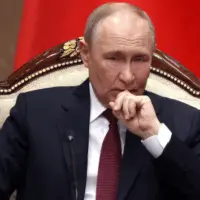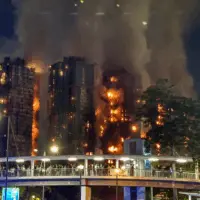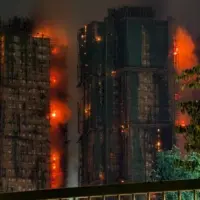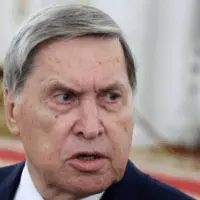
(LONDON and KYIV, Ukraine) — Russian President Vladimir Putin appeared last week to be cautiously optimistic on the U.S. 28-point peace plan to end his invasion of Ukraine, but statements made by his emissaries in the days since then have led some analysts to believe he thinks he can get a better deal.
“I believe that it could also form the basis for a final peace settlement, but this text has not been discussed with us in detail,” Putin told his Security Council on Friday.
Momentum has appeared to be building as U.S., European, Ukrainian and Russian representatives met first in Geneva, Switzerland, and then in Abu Dhabi in the United Arab Emirates. U.S. President Donald Trump has now said a deal could be “very close” and has ordered his envoy Steve Witkoff to travel to Moscow next week to present the plan to Putin.
But despite the diplomatic flurry and public optimism, many close observers of Russia still doubt Putin is actually ready to take a deal now or sees much need to compromise.
“I see nothing at the moment that would force Putin to recalculate his goals or abandon his core demands,” Tatiana Stoyanova, founder of R.Politik and a senior fellow at the Carnegie Russia Eurasia Center wrote on X.
“He feels more confident than ever about the battlefield situation and is convinced that he can wait until Kyiv finally accepts that it cannot win and must negotiate on Russia’s well-known terms,” Stoyanova said. “If the Americans can help move things in that direction — fine. If not, he knows how to proceed anyway.”
Boris Bondarev, a former Russian diplomat who quit in protest after Russia’s 2022 invasion, also told ABC News he thought it “most likely” that this latest round of negotiations will fizzle out with the combatants still far apart on key issues, as has been the case with previous efforts.
The new 19-point plan negotiated with Ukraine this week is highly unlikely to align with Moscow’s goals, Bondarev said. Even the original 28-point plan that Russia helped draw up with Witkoff “wasn’t fully acceptable to Russia in the first place,” he said, pointing to the Kremlin’s apparent hesitance to commit to the initial blueprint.
“Now it’s even less acceptable,” he said. “So, of course, they would not accept it.”
But Bondarev didn’t rule out entirely that Putin might lunge for a deal that contains many of his demands.
“Of course, we can and we should be ready for any surprises from the Kremlin,” he said. “They can still surprise sometimes.”
The original 28-point U.S. proposal that heavily favored Russia was revised down to 19, according to U.S. and Ukrainian officials, during the Geneva negotiations.
Some of the most unacceptable points to Kyiv have been removed, according to sources familiar with the discussions, including a cap on Ukraine’s army and a war crimes amnesty. But it is not entirely clear what the new plan includes and the most intractable issues, including Ukraine ceding more unoccupied territory remain.
Kremlin spokesperson Dmitry Peskov on Wednesday again downplayed hopes for a deal, saying it was “too early to say” whether the warring parties are close to an accord. Russia’s deputy foreign minister has since said Moscow will not make any major concessions.
Previous rounds of talks have resoundingly failed. And, while the U.S. has been projecting hope, it’s unclear how serious Russia — which has been eking out battlefield gains — is about making peace.
“Putin does not want an agreement,” John Herbst, a former U.S. ambassador to Ukraine, said at an Atlantic Council event on Tuesday. “The only agreement he wants is diktat — a Ukrainian surrender. Otherwise, he wants to continue fighting.”
“I suspect if Ukraine had accepted those dreadful 28 points, Putin would come back for more,” Herbst said. “He realizes those 28 points reflected great flexibility moving his direction on the part of the United States, and he would say, ‘See what else we can get’.”
Putin’s long march
The Kremlin has indicated that the new peace plan was discussed at the summit between Putin and Trump in Alaska in August.
Putin left Alaska with Trump’s endorsement of the “fantastic relationship” between the two presidents, having successfully neutralized Trump’s previous demand he agree an immediate ceasefire and pushing off the threat of more American sanctions, while gaining the prospect of potentially lucrative bilateral economic cooperation.
Despite a nominal commitment to peace talks, as summer turned to fall, Russia only intensified its frontline offensives and expanded its long-range attacks on Ukrainian cities and critical infrastructure, according to information released by Russian and Ukrainian forces.
Russian forces have captured some 350 square miles of Ukrainian territory — roughly the same area as the German capital of Berlin — since Trump and Putin sat down together in Alaska, according to data from the Institute for the Study of War think tank.
Putin has for years said that any peace deal in Ukraine must reflect the “new territorial realities” of Russian occupation of large chunks of the country. As Russian troops edge forward, Putin appears to be trying to entrench those territorial realities.
That new territory is a tiny sliver of the roughly 44,600 square miles — nearly 20% — of Ukraine controlled by Russian forces. But despite the slow rate and reportedly high human cost of Russia’s advance, independent military analysts worry it reflects a growing momentum for Moscow.
A high-profile advance around the destroyed Donetsk city of Pokrovsk and an unexpected local breakthrough on Ukraine southern Zaporizhzhia front have further burnished the Kremlin’s propaganda campaign promoting what they claim as an inevitable Russian victory.
Relentless Russian drone and missile strikes continue to kill civilians and wreak havoc on Ukraine’s critical infrastructure, particularly the energy grid. Concentrated strikes on power stations and natural gas infrastructure have precipitated rolling blackouts in many parts of the country — including in Kyiv — as winter bites.
Zelenskyy’s government has also been rocked by a corruption scandal that has seen two cabinet ministers removed from their posts and figures close to the president investigated.
Bondarev said he believes Russia is repeating its strategy of delay and obfuscation. Putin is “playing for time,” he said, and “outsmarting” his Western adversaries.
“Putin says we need to remove the root causes of the war,” Bondarev said. “You cannot remove these root causes of the war just by signing some memorandum. You need to work it through. It takes a lot of experts, meetings, coordination — so it may take months. And at the same time, he will be fighting.”
“With each new tiny victory — every new village occupied, every square kilometer occupied — the Russian position will be more and more robust, less and less flexible,” Bondarev said.
Red lines
“People’s expectations for how long a process like this will take are wildly exaggerated,” Samuel Charap, a senior political scientist at the RAND Corporation, told ABC News this week.
“I think even in the best case we are talking about months not weeks,” Charap added.
Still, Charap said, the new push by the Trump administration was positive, noting it had jumpstarted negotiations and for the first time produced a framework document that at least included almost all the core issues of the conflict.
“You have to give them credit, they have certainly shaken up the stasis which had set in,” he said. “There are conversations happening that weren’t happening a week ago.”
Ukrainian lawmakers and analysts told ABC News there remains little hope in Ukraine that Putin can be trusted to abide by the terms of any peace deal. That is why Kyiv’s demands for Western security guarantees, NATO membership and more military aid have been so central to the Ukrainian negotiating position.
Still, Yehor Cherniev — a member of the Ukrainian parliament and the chairman of his country’s delegation to the NATO Parliamentary Assembly — told ABC News that the framework established with the U.S. “is a good signal and it’s good progress in our peace negotiations, because before we were stuck.”
But some “red lines” remain, Cherniev said, “as before, about the concession of our territories or of or our sovereignty.” Ukrainian officials have said they want to leave such thorny topics to a meeting between Trump and Zelenskyy at the White House.
“I have doubts that Russia will agree with this,” Cherniev added.
Oleksandr Merezhko, another member of parliament and the chair of its foreign affairs committee, told ABC News he believes “Putin will reject this peace plan and will reiterate his maximalist demands.”
“He is not interested in peace or ceasefire — he is only interested in our surrender,” Merezhko said. “We should insist not on a ‘peace treaty’ but on a ceasefire agreement.”
Zelenskyy has consistently urged more pressure on Russia twinned with more muscular Western military aid for Kyiv. Trump has often threatened a tougher line on Moscow, but — according to Daniel Fried, a former U.S. ambassador to Poland — it is unclear if he is willing to deliver.
“In the end, Trump is going to have to stare down Putin to get his deal in any kind of decent form,” Fried said at an event Tuesday.
But Bondarev said he sees little hope of an imminent change in U.S. strategy, suggesting that any disunity within the administration will only further strengthen Moscow’s hand.
“Western diplomacy has never tried to get the initiative, to first elaborate its own agenda and impose it on Russia,” the former diplomat said. “They only follow what Russia is doing. You can never prevail if you just follow your adversary and let him lead.”
“Trump mentioned that ‘it takes two to tango,'” he added. “But there is someone in every couple who leads and someone who follows.”
Copyright © 2025, ABC Audio. All rights reserved.














